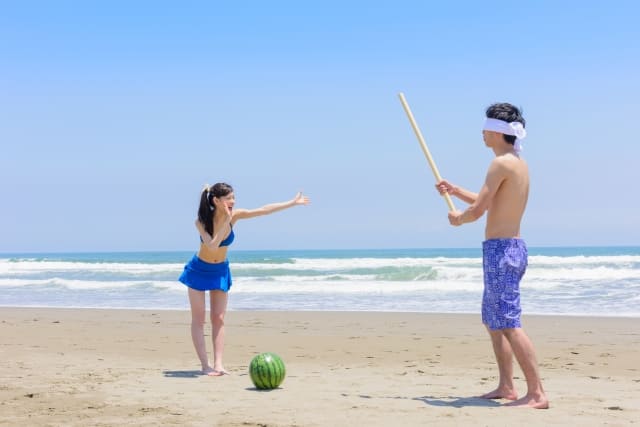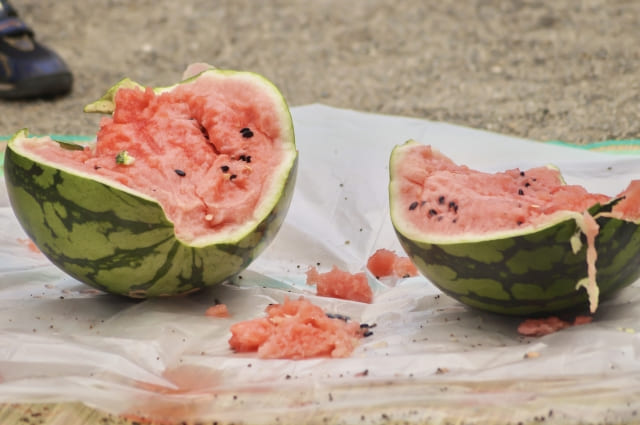When you think of summer in Japan, what comes to mind? Beach trips, fireworks festivals, and… Suika-wari!
Under the summer sun, everyone gathers around a big watermelon, cheering and laughing, as someone tries to smash it while blindfolded.
It may sound simple—“just hit a watermelon with a stick”—but once you try it, you’ll find it’s way more exciting than you expected.
In this article, we’ll explain the basic rules of Suika-wari, explore its mysterious origins, and share tips to make it even more fun and safe to play.

After reading, you might be ready to become the “Suika-wari master” at your next summer gathering!
What Is Suika-wari?
Basic Rules of Suika-wari

Suika-wari is a traditional Japanese summer game where a whole watermelon is placed on the ground, and a blindfolded player tries to smash it using a stick.
The player starts from a set distance away and has no idea where the watermelon is—relying only on directions shouted by others.
When the stick finally lands a perfect hit and the watermelon cracks open, the cheers and excitement are unforgettable.
The Key: Voice Guidance

One of the most fun aspects of Suika-wari is the guidance from spectators.
You’ll hear shouts like, “A little to the left!” or “Go straight ahead!”—often mixed with teasing or playful misdirection to make things more challenging and hilarious.
Where It’s played: Not Just at the Beach!

While Suika-wari is often played on the beach, it’s also popular at school events, summer festivals, and campsites.
Its appeal lies in how easy it is to set up and play anywhere.
The Origins of Suika-wari

Do you know the origins of Suika-wari?

I don’t know anything.
But I’m curious!
Popular Since the Showa Era

There are no official records of when Suika-wari began, but it’s believed to have spread widely during Japan’s Showa period (1926–1989) as a summer recreational activity.
The Samurai Sword Theory

Some say the game may have been inspired by tameshigiri (samurai sword test-cutting) or iaigiri (quick-draw sword techniques). The stance and motion of striking do resemble swinging a sword.
The Truth Is Unknown

In reality, the exact origins are unclear. What’s certain is that it naturally became a beloved summer tradition in Japan.
Tips for Enjoying Suika-wari
Place a Sheet Under the Watermelon

When the watermelon bursts, juice and fruit can scatter everywhere. Placing a picnic sheet or tarp underneath helps keep it clean and ready to eat.
Add the “Spinning” Rule for More Challenge
For middle schoolers and older, try adding a twist: blindfold the player and have them spin in place 4–5 times before starting. This disorients them and makes the game even more fun to watch.
Safety First
Use a lightweight wooden or plastic stick, and make sure everyone stands a safe distance away. Keep the area clear so no one accidentally gets hit.
Suika-wari Q&A

- QCan we use any stick for Suika-wari?
- A
For safety, it’s best to use a lightweight wooden or plastic stick rather than a heavy bat.
- QDo we always have to wear a blindfold?
- A
Usually yes, but for small children, it’s fine to skip the blindfold for safety.
- QCan we eat the watermelon afterward?
- A
Yes! As long as you place a sheet underneath, you can cut and enjoy it right after the game.
Final Thoughts about Suika-wari
Suika-wari is a simple yet exciting way to enjoy summer in Japan. Whether at the beach, at school, or in your backyard, it’s a game that brings people together through laughter, playful competition, and the sweet reward of fresh watermelon at the end.
Its origins may be a mystery, but that’s part of its charm. This summer, why not grab a watermelon, gather your friends or family, and try Suika-wari for yourself? It’s sure to be a day full of smiles, cheers, and delicious memories.

If you like gaming, and you are also interested in Japan, you may love these Japanese themed games!

Yes! Let’s play!




Comments